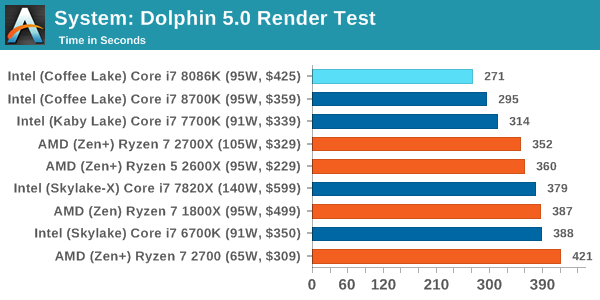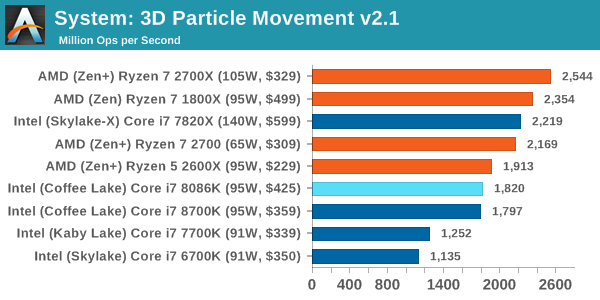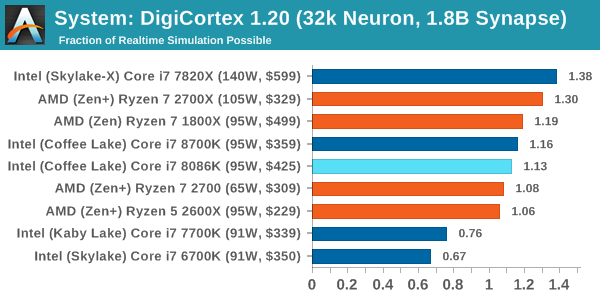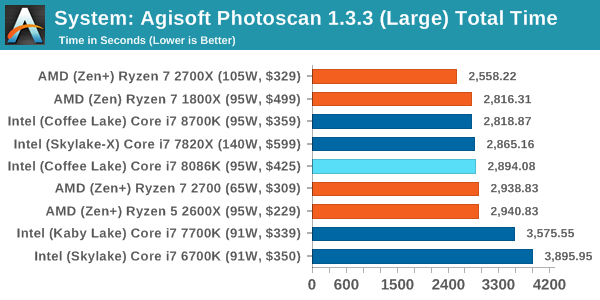The Intel Core i7-8086K Review
by Ian Cutress on June 11, 2018 8:00 AM EST- Posted in
- CPUs
- Intel
- Core i7
- Anniversary
- Coffee Lake
- i7-8086K
- 5 GHz
- 8086K
- 5.0 GHz
Benchmarking Performance: CPU System Tests
Our first set of tests is our general system tests. These set of tests are meant to emulate more about what people usually do on a system, like opening large files or processing small stacks of data. This is a bit different to our office testing, which uses more industry standard benchmarks, and a few of the benchmarks here are relatively new and different.
All of our benchmark results can also be found in our benchmark engine, Bench.
FCAT Processing: link
One of the more interesting workloads that has crossed our desks in recent quarters is FCAT - the tool we use to measure stuttering in gaming due to dropped or runt frames. The FCAT process requires enabling a color-based overlay onto a game, recording the gameplay, and then parsing the video file through the analysis software. The software is mostly single-threaded, however because the video is basically in a raw format, the file size is large and requires moving a lot of data around. For our test, we take a 90-second clip of the Rise of the Tomb Raider benchmark running on a GTX 980 Ti at 1440p, which comes in around 21 GB, and measure the time it takes to process through the visual analysis tool.

FCAT is single threaded, however in this test the full 5.0 GHz did not kick in.
Dolphin Benchmark: link
Many emulators are often bound by single thread CPU performance, and general reports tended to suggest that Haswell provided a significant boost to emulator performance. This benchmark runs a Wii program that ray traces a complex 3D scene inside the Dolphin Wii emulator. Performance on this benchmark is a good proxy of the speed of Dolphin CPU emulation, which is an intensive single core task using most aspects of a CPU. Results are given in minutes, where the Wii itself scores 17.53 minutes.

For a test that did have 5.0 GHz kick in, the 8086K takes the record in our Dolphin test.
3D Movement Algorithm Test v2.1: link
This is the latest version of the self-penned 3DPM benchmark. The goal of 3DPM is to simulate semi-optimized scientific algorithms taken directly from my doctorate thesis. Version 2.1 improves over 2.0 by passing the main particle structs by reference rather than by value, and decreasing the amount of double->float->double recasts the compiler was adding in. It affords a ~25% speed-up over v2.0, which means new data.

On 3DPM, the 8086K shows that the 4.3 GHz all-core is on par with the 8700K.
DigiCortex v1.20: link
Despite being a couple of years old, the DigiCortex software is a pet project for the visualization of neuron and synapse activity in the brain. The software comes with a variety of benchmark modes, and we take the small benchmark which runs a 32k neuron/1.8B synapse simulation. The results on the output are given as a fraction of whether the system can simulate in real-time, so anything above a value of one is suitable for real-time work. The benchmark offers a 'no firing synapse' mode, which in essence detects DRAM and bus speed, however we take the firing mode which adds CPU work with every firing.

Despite the faster single core frequency, this DRAM-limited test seems to load up another core and stops the 8086K from reaching 5.0 GHz.
Agisoft Photoscan 1.3.3: link
Photoscan stays in our benchmark suite from the previous version, however now we are running on Windows 10 so features such as Speed Shift on the latest processors come into play. The concept of Photoscan is translating many 2D images into a 3D model - so the more detailed the images, and the more you have, the better the model. The algorithm has four stages, some single threaded and some multi-threaded, along with some cache/memory dependency in there as well. For some of the more variable threaded workload, features such as Speed Shift and XFR will be able to take advantage of CPU stalls or downtime, giving sizeable speedups on newer microarchitectures.

Agisoft is variable threaded, but the 8086K is still a small stones throw from the 8700K.










111 Comments
View All Comments
rocky12345 - Monday, June 11, 2018 - link
They used to but Intel coolers are so bad that no one used them so instead of making one that was usable for the k CPU's they just stopped including them. At least the other guys include them still and 2 of the 3 are actually usable as coolers. Personally I would rather have some sort of cooler included so at least would be up and running if the high end air or water cooler was om back order or waiting on shipping at least can get the system built and running.Flunk - Monday, June 11, 2018 - link
The ones they sent out with the older -K series processors were a joke. My i5-2500K came with a cooler that couldn't even cool it within Intel's specs running stock in a cold room.mkaibear - Tuesday, June 12, 2018 - link
I'm still using the one which came with my 4790K and it works fine, and the one my 2500K came with also worked fine when I had it, even at 30C ambient temps in the middle of summer.Probably an installation error there Flunk.
(yes, I bought K series processors and never overclocked them, for both of these my intention was to downclock them for reduced heat and noise but never got round to it with the 2500K and the 4790K didn't really downclock very well so I couldn't be bothered!)
jimmysmitty - Friday, June 15, 2018 - link
Absolutely incorrect. I installed tons of the stock Intel coolers on i5s and i7s and they work as specified for the stock settings of the CPUs plus were normally very quiet.SirMaster - Monday, June 11, 2018 - link
"K" CPUs con't come with heatsinks or fans... Neither does the 8700K or 8600K or 7700K, etc.Matthmaroo - Monday, June 11, 2018 - link
It’s been a while for you , I see - K series cpus have no coolerMemo.Ray - Monday, June 11, 2018 - link
Memo.Ray - Monday, June 11, 2018 - linkAs I mentioned in my comment in the other article a couple of days ago:
Intel managed to give away 8086 "binned" 8700K (AKA 8086K) and still make some money on top of it. win-win situation :D
https://www.anandtech.com/comments/12940/intels-co...
jimmysmitty - Friday, June 15, 2018 - link
And you miscalculated because you used the i7 8700 cost not the 8700K cost. They made maybe $300K on them.You know I have never seen anyone complain about say a 40th anniversary version of a car.
just4U - Wednesday, June 13, 2018 - link
If it were more similar to the 4790K with a better thermal design (think devils canyon..) it's something I'd be interested in over the 8700K. It's not tho… and doesn't even come with a specialty cooler that might peak interest.. but rather "NO COOLER" at all.. I dunno..I think Intel missed the boat with this one.
MDD1963 - Tuesday, June 26, 2018 - link
Who *actually* thought, after so many years of Intel not giving coolers with it's "K" model variants, that this one might come with a bundled cooler? :)